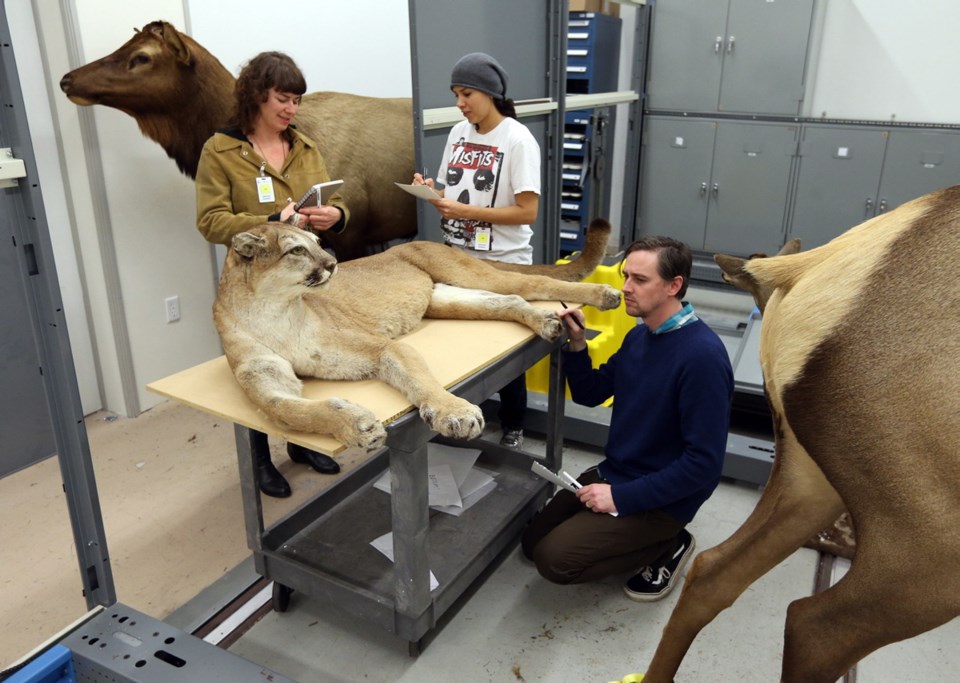It’s no surprise to find historical art in a museum, but less common is the modern-day artist. That recently changed at the Royal B.C. Museum, where three local artists are settling in for the first time together.
Lindsay Delaronde, Gareth Gaudin and Aimée van Drimmelen are more than three months into a year-long residency, which they’ll spend exploring and creatively interpreting all the museum has to offer.
“We’ll look at the whole museum and archives as an institution and respond to it creatively,” said Chris O’Connor, who co-ordinated the residency as the schools and family learning team lead for the museum.
In addition to taking part in the museum’s Wonder Sunday and Night at the Museum events, the three artists are going behind the scenes to chronicle the specimens and artifacts comprising the museum collections. On the day of this interview, they had just toured the ethnology section, learning about cultural sensitivity issues embedded in that section of the museum’s collection.
They’re just getting started, but they’re already knee-deep. Two months ago, Gaudin, the cartoonist and painter behind Perogy Cat, set up a mylar screen in Old Town’s Majestic Theatre, sketching on-demand for children.
Delaronde, an Iroquois-Mohawk artist who grew up on the Kahnawake reserve, held a storytelling session with masks and drums in the First People’s Gallery, as well as a silkscreen printing workshop.
Van Drimmelen has begun documenting the experience through writing, sketches and animations in a creative online blog (aimeesketchblog.wordpress.com).
The attraction to the project for each of the artists was different.
“I’ve been coming here since I was two or three and I know there’s a lot going on behind the doors and behind the exhibitions. So being offered the opportunity to explore was pretty exciting,” Gaudin said. “Every time we go into a new area, there’s a thousand ideas for potential art projects.”
He likened the experience to being an urban explorer, except a little less dangerous than sneaking into sewers and other forbidden spaces.
And while the content of the collections has been one thing, equally interesting to Gaudin has been meeting the people who create them.
“They’ve all been really intriguing people. And so is the idea that they’re just holed up in their line of work, locked in a tower with thousands of pieces of works and other people’s art,” he said.
O’Connor was quick to point out that the curators and collection managers do, in fact, go outside sometimes.
For van Drimmelen, the museum staff has been a pleasant surprise.
“It sounds so dumb, but I didn’t even think of the fact that there are these scientists and trained people working behind the scenes at a museum,” she said.
Van Drimmelen’s work often features plants, animals and other natural themes. So, she said, she has particularly enjoyed exploring the botanical section.
She’s also combining her journalistic background with illustration through the blog, which she’s using to document the experience.
“It’s only just getting started now, but my goal is to do a little report with visuals from each of the collections we visit,” she said.
While van Drimmelen’s intended audience is the public, O’Connor said it has also been a hit with the curators and collections managers.
“They’re thrilled by it. It’s even given them some new ideas about things that they look at all the time. So it’s been interesting to see that sort of back and forth. They’re playing host to the artists in their space, but they’re also witness to their work, as well as being influenced by it,” he said.
Delaronde said the residency has allowed her to flex her performance muscles.
Artists have a way of making people see things in new ways, she said, so she hopes their work helps to animate visitors’ relationships with the museum.
“A lot of the typical museum experience is about etiquette, rules of where to stand; everything is behind glass. The museum has this life entity that has existed for many years, so it’s sort of about breaking the norms of how we interact with museums,” she said.
“Being more tangible and hands-on with things, I think supports the learning experience, too.”
In addition to inspiring new projects, Gaudin said the residency seems to be changing the way people look at him as an artist.
“Usually as artists, we’re envied for all the time it looks like we just sit around. But nobody’s really intrigued by that,” he said. “When you’re associated with a museum and you get to go behind the scenes, people are interested with what we’re doing, rather than what we’ve done.”
It adds a certain momentum to his work.
“The anticipation for the art that will come out of this is a motivating factor.”
While Delaronde, Gaudin and van Drimmelen are just getting started, O’Connor said he’s pleased with the results. Artistic residencies are already commonplace in art galleries and becoming more common in science centres, he said, but the natural history museums are still catching up.
It also revitalizes a traditional link between art and museums, he said. Decades ago, before cameras were attached to every cellphone, curators were expected to arrive with accurate sketching abilities, which required observation and attention to detail.
“The ability to put that on paper in a creative but illustrative way — that was just part of the practice of being in a museum. And we’ve lost that a little bit,” he said.
“So to bring that back and have artists look at the museum creatively, I felt it was a good time to do that here.”
